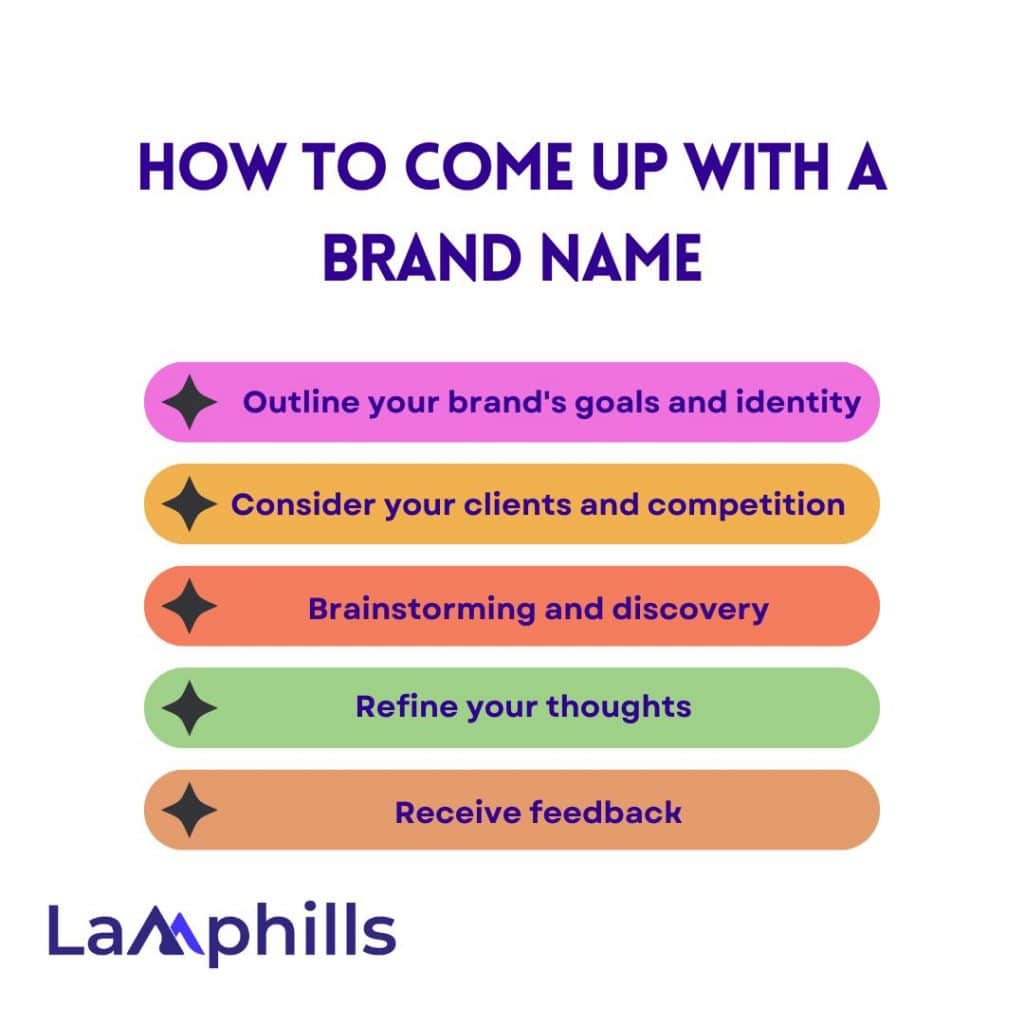Walking down the supermarket aisle, I came across a brand of cookies called “Crunchy Dreams.” The name not only piqued my interest, but it also took me back to childhood memories of baking with my grandmother. As a brand strategist, this moment reminded me of the importance of a well-crafted brand name—it’s more than just a label; it’s a story, an experience that customers connect with. Creating such a name, however, is no easy task.
As a Branding Specialist, I’ve helped innumerable entrepreneurs develop name ideas. While smart wordplay and catchy rhymes are entertaining, memorable brand names go deeper. They appeal to the psychology of your target audience, eliciting emotions and leaving a lasting impact.
But, beyond the well-worn advice to “keep it short and sweet,” there is a universe of psychological considerations waiting to be discovered. Let us explore the components of a strong brand name, allowing you to design a name that resonates with your target audience.
Key Takeaways
- A well-crafted brand name serves as more than a label; it embodies a story and experience, connecting emotionally with consumers and leaving a lasting impression.
- Effective brand names should incorporate psychological elements, appealing deeply to the target audience’s emotions to enhance memorability and impact.
- Research indicates that brand names that are easy to pronounce and remember can significantly boost a brand’s recognition and trust among consumers.
- The process of creating a powerful brand name involves a blend of creativity, strategic thinking, and an understanding of consumer psychology.
- Beyond simplicity and catchiness, brand names should avoid being generic, overly complex, or irrelevant to the brand’s identity to ensure they resonate well with the intended market.
Understanding the Impact of a Strong Brand Name
A brand name does more than just identify your firm; it expresses its essence and ideals to the globe. According to a University of Loyola, Maryland study, a brand name can enhance recognition by up to 80%. This statistic emphasizes the brand name’s importance not just in recognition but also in establishing a lasting impression. As a result, the process of naming your brand requires a combination of creativity, strategic thinking, and consumer psychology.
A recent study by the University of California, Berkeley discovered that consumers are more likely to recall and trust businesses with easy-to-pronounce and spelled names. This emphasizes the value of clarity and simplicity while creating a brand name.
What Constitutes a Memorable Brand Name?
While coming up with a brand name is not an exact science, there are some traits you should include—a random word or phrase will not suffice. The brand name should be:
- Evocative: It should inspire a favorable emotional response from potential clients and encourage them to learn more about your product or service.
- Catchy: It should be easy to remember and can incorporate elements such as alliteration or play-on-words to increase its appeal.
- Simple to spell and pronounce: You don’t want consumers to struggle while reading or writing your brand name. Simplicity is crucial.
A good brand name should be recognizable, whether through musicality or metaphor.
What Should Not Be Your Brand Name
Here are some things to avoid while coming up with your brand name:
- Unmemorable: A brand name should be memorable and simple to remember. Avoid names that are excessively long, complicated, or difficult to say.
- Generic or descriptive: A good brand name should be distinctive and distinguishable from the competition. Avoid using general or descriptive names for your product or service.
- Difficult to spell or say: This can cause misunderstanding and dissatisfaction among your intended audience.
- Offensive or contentious names might harm your brand’s reputation.
- Too similar to another brand can result in legal difficulties and consumer confusion.
- Limiting: A brand name should be broad enough to accommodate future product or service offers.
- Unrelated to your brand: Your brand name should reflect your brand identity and explain your key beliefs.
- Trademarked: Before deciding on a brand name, check for trademark availability.
- Short-lived: Avoid names based on current trends or fads.
- In a foreign language: This may repel potential clients who do not understand the language.
In addition to these broad rules, there are several specific items you should avoid based on your brand:
- For a professional brand, avoid names that are too casual, whimsical, or slangy.
- For a luxury brand, avoid names that are overly common, average, or discount-sounding.
- For a children’s brand, avoid titles that are too smart or adult-oriented.
- For a technology company, avoid names that are overly technical or jargon-filled.
How To Come Up With a Brand Name

Now that you’ve got name ideas and rules to follow, it’s time to go into the specifics of how to name a brand. This approach is most effective when combined with your brand positioning plan, so devote time to that work before beginning the naming process.
#1. Outline your brand’s goals and identity
Defining your identity and ambitions explains what distinguishes you from the competition and how you intend to position your firm. You can find this information in your positioning statement. If you don’t have one yet, ask yourself these questions:
- Why does your company exist? This is your vision.
- What does your company do? This is your mission.
- How do you accomplish what you do? This relates to your values. Fun fact: 89% of customers stick to brands that share their values.
- What brand identity do you want to create? This is your brand’s personality.
- What do you hope to accomplish with the brand name? Perhaps you want customers to understand your service right away, or you want to emphasize your innovative attitude.
Once you’ve answered these questions, it’s time to gaze outside.
#2. Consider your clients and competition
No brand can succeed in a silo, so choose a name that resonates with your target demographic and industry. That’s because individuals frequently associate themselves with the brands they purchase. This is fantastic news for businesses, as customers who have an emotional connection with a brand have a 306% higher lifetime value.
Consider customer feedback and surveys while coming up with a brand name. This input can reveal how people perceive your brand, which is useful when considering names. If clients remark about how much fun it is to work with your team and use your product, it makes no sense to establish a serious brand name or character.
Another important consideration is your industry. What are the naming conventions? What do your competitors do? Based on your brand strategy, you must determine whether to follow industry conventions or to choose an unconventional name that distinguishes your brand.
#3. Brainstorming and discovery
Yes, it is time to get out of the whiteboard. But first, form a team to brainstorm ideas and gain approvals. You must define who is participating in the decision-making process. If you’re a solopreneur, invite a few trustworthy peers or colleagues to participate.
Fill up your board with whatever thoughts come to mind, and if you’re stuck, consider:
- Adjectives that characterize your service, product, or brand.
- How people perceive your brand, or how you want them to feel
- Words that you wish to identify with your business
While brainstorming, evaluate what you believe makes a strong brand name and any big naming concerns you may have.
#4. Refine your thoughts
You presumably have a vast collection of brand names—which is a good thing. Chopping is easier than creating. Begin narrowing down your choices by considering the following criteria for each name:
- Does it reflect your brand’s personality?
- Does it have emotional resonance?
- Does it have meaning or relate to your company’s story?
- How does it look on paper versus on screen?
- Is there a trademark for it?
- Is the domain name and social media handles available?
- Does it distinguish itself from the competition?
- Is it brief, memorable, and simple to spell and pronounce?
Make a selection of 10-15 names for the following phase. If you have less than this, that’s fine; just strive for three to five possibilities.
#5. Receive feedback
There is nothing like soliciting input from your staff, customers, stakeholders, or colleagues. You’ll quickly find out if a name contender is difficult to say or offends others. To avoid groupthink, seek individual perspectives from a varied group of people.
Once you’ve gathered feedback, it’s important to check how the final options translate across languages. Consider where your company will operate and where you want to expand. Wix learnt this lesson the hard way, but the humor-oriented brand handled it admirably.
#6. Ensure availability
A unique name is nothing if you cannot utilize it. Check for trademark and domain availability to check that the name you choose is legally and digitally useable.
Ten Types of Brand Names to Consider With Examples
Here are ten categories of brand names to consider:
#1. A made-up name – Sony
Brand names in this category are made-up words that were chosen because their pronunciation conveyed the desired mood or value. There may also be a secret meaning underlying any or all of the names. Sony, an international electronics label, is a mashup of the Latin term sonus, which means “sound” or “sonic,” and the English word sonny, which is a child’s nickname. Together, these terms represent the concepts of youth, music, and creativity—characteristics that remain appropriate for the brand no matter how much it evolves.
To come up with a made-up name, use the list of phrases you prepared to clarify your brand principles and let your imagination go wild. Experiment with different variants and sounds, combining syllables from other words, and see what you come up with. This is undoubtedly a trial-and-error procedure, but with some time and conversation with coworkers or friends, you may find yourself a clear winner.
#2. Results-oriented name – IMPACT
These names, whether generic or specific, express what your company will perform for its customers. For example, IMPACT, the name of a digital marketing organization that assists businesses with partnership management, carries a strong connotation. The name immediately draws your interest, even before you know what they are selling.
Think about the emotion you want to elicit in your customers to come up with a result-oriented brand name. Consider adverbs that characterize what you’re selling or how you’ll deliver it to customers (quickly, strategically, creatively, etc.). Can you include any of these words in your title?
#3. Metaphorical name – Nike
There is a reason Nike chose this brand name. Nike was the goddess of triumph in ancient Greek mythology, which is a natural fit for a sports equipment manufacturer’s mentality. Metaphors are all about comparing your brand to something else that has the same features or qualities that you claim to have.
To take this approach, consider the most noticeable attribute you want to be identified with. Then, try to pick one animal, one plant, one natural scene, one renowned individual, and one location that exemplifies this characteristic. If one of your selections elicits the appropriate feeling, you may have a suitable candidate.
#4. The trasperent name – 5-Hour Energy
Transparent brand names inform consumers about what the company does or sells right up front. By reducing the guesswork, your clients may more quickly envision themselves using your product or service. To improve your tag, consider using an adjective or a play on words. One example is 5-Hour Energy. You’ve definitely noticed these little, colorful vials at your neighborhood pharmacy’s checkout counter. They depict a silhouette of a person running across a mountainous landscape, with the name inscribed in bold black letters. Without even picking up the product, you know it’s an energy drink.
Transparent brand names are suitable for a wide range of products and services. If you want to take this way, think about what you sell and if the title sounds good. You should be able to label your goods in three words or less, as most brand names do not surpass that limit. You can also experiment with metaphorical aspects to add some creativity.
#5. A double-meaning name – Instagram
These brand names combine up to two words that describe your brand into a single, memorable tag. Two-in-one names are helpful at generating consumer attention and conveying a concept of what the product or service is. Instagram is a social networking program that combines the words instant camera and telegram. The founders, Kevin Systrom and Mike Krieger, wanted the name to express ease and spontaneity while also appealing to a younger, tech-savvy consumer.
Want to attempt this type of brand name? Examine both your list of values and the terms that describe your principal product or service. Try combining a few of these terms into a single tag that represents your brand.
#6. Founder’s name – Ben and Jerry’s
This is likely the oldest trick in the book. Giving your firm your first name, family name, or nickname personalizes your brand and instills trust. A fantastic example is Ben & Jerry’s. By adopting the founders’ daily first names (Ben rather than Benjamin), the legendary brand creates a comfortable, laid-back atmosphere that is continued throughout their branding, from the colorful packaging to the funny ice cream flavor names.
If you decide to go this path, keep in mind that a first name is always more casual, whereas a last name seems more formal. If you aren’t very proud of your own name, consider stealing one from a friend, family member, or even your pet.
#7. Foreign-language name – Panera
A business owner may decide to incorporate a word from another language for a variety of reasons. It could be due to their personal past or just because they enjoy the sound of it. In any case, it should be applicable to the given industry. Take a look at the famed fast casual eatery Panera. The name translates to “bread basket” in Spanish, which is consistent with their products. Interestingly, Panera owns Au Bon Pain (“the place with the good bread” in French), another American bakery brand. The founders chose these names because they sound tasty, but also because European countries (particularly France) are thought to be the birthplaces of traditional baking processes.
If this style of name appeals to you, consider the terms on your values list or the product you’re offering. Use Google Translate or other dictionaries to look up translations in other languages. Before you choose a foreign term, consult with a native speaker to ensure that it does not communicate unexpected implications. The global map represents the boundary.
#8. An abbreviated name – IKEA

Have many things to say? Consider utilizing an abbreviation as your brand name. It allows you to include a phrase or many words that do not naturally fit together. For example, while you may believe IKEA is a Swedish phrase that means “put-it-together-yourself-and-feel-like-you-ran-a-marathon-afterwards,” the furniture giant’s name is an abbreviation. The I and K come from the founder’s name, Ingvar Kampra, while the E and A come from the name of the farm he grew up on, Elmtaryd, followed by the name of the village, Agunnaryd. While nothing in the name IKEA refers to what the store sells, it has become a global household name linked with furniture.
To come up with an abbreviated brand name, jot down the first letter of each phrase you want to incorporate. Try fitting them together in different orders. Does anything sound good?
#9. A name that communicates leadership – Best Buy
These names are intended to convey the brand’s sense of leadership in its industry.
Best Buy, an electronics retailer, is an excellent example. They want customers to know that they are the greatest store for laptops, appliances, and technology equipment. The use of alliteration gives a catchy factor to the name, which increases its appeal.
To use this strategy, think about how your product or service stands apart in your industry. Can you convey this through your brand name? A list of words you can draw on includes:
- Best
- Top
- Choice
- Superior
- Royal
- Core
- Finest
- Supreme
- Prime
- First
#10. A name without any hidden meaning – Apple

These brand names have no special connection to the product or service, but were picked for their eye-catching ring. How did Steve Jobs come up with the name Apple for his IT company? After returning from an apple farm one day, he thought the name would make the brand sound “fun, spirited, and not intimidating.” He was not mistaken!
Using a name like this can be an effective corporate branding approach for distinguishing your company from competitors with transparent tags. It informs customers that you operate in a unique manner compared to competitors in your industry.
Brand Name Evaluation Template
A Brand Name Evaluation Template can help to streamline the decision-making process. This form lets you rank prospective names based on factors including memorability, relevancy, legal availability, and emotional impact. Quantifying these variables allows you to make a more educated decision about your brand name.
Tools To Help You Create a Brand Name
If you’re not sure how to choose a brand name, these tools combine AI technology and data processing to filter out unavailable names and provide suggestions depending on your input.
- NameSnack: NameSnack blends machine learning with domain and keyword searches to develop a variety of name styles for your company. This tool also has a logo maker.
- Brandroot: Brandroot is a “premium business name generator” that searches the internet for available names and domains in minutes.
- FreshBooks: FreshBooks asks simple questions about your sector and niche before presenting you with options.
- Namelix: Namelix claims to “generate short, brandable business names using AI.” It can also design a logo with your new brand name.
Keep in mind that software lacks a personal touch or overlooks essential elements that you may want to provide. If you’re stuck, these tools may provide some inspiration.
Is Your Brand Name Ready To Share Its Story?
Choosing a brand name is similar to laying the groundwork for your brand’s identity. It involves a combination of creativity, market knowledge, and strategic insight. As you embark on this creative path, consider whether your brand name has the potential to become a household name. How will you ensure that your legacy is carried forward?
At Lamphills, we are eager to assist you in realizing the full potential of your brand name. Are you ready to start this revolutionary journey?
Related Articles
- How To Build & Measure Brand Affinity: The Ultimate Guide to Fostering Lasting Connections
- Brand Advertising: Elevating Your Brand Awareness
- Unlocking the Power of Brand Equity: A Comprehensive Guide
- 7 Simple Practical Steps to Build Brand Loyalty
- HOW TO MEASURE BRAND AWARENESS: Tips To Improve Your Brand Strategy






